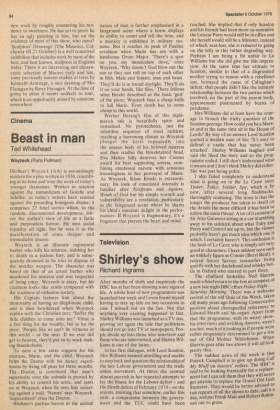Abstractions
John McEwen
The unenviable lot of the successful middle-aged artist is that ordeal by fire, the mid-career retrospective. Currently it is the turn of John Hoyland (Serpentine Gallery till 28 October; Birmingham City Art Gallery, 9 November — 9 December; Mappin Art Gallery, Sheffield, 2 February — 2 March), who for more than a decade has widely been considered England's champion abstract painter. As it turns out he retains the tide effortlessly. In fact it is difficult to imagine that better colour abstractions than some of these have been done anywhere in the world over the past ten years. It is a great achievement, particularly when one considers that there was no postfauvist tradition in English painting for Hoyland to build on when he began and has been little fashionable concern for this kind of painting, indeed for painting in general, throughout most of his career. Now the avant-garde is fragmented and painting has found its place again. There is a hunger for more direct and physical expressions of art. It is luck he deserves.
Bryan Robertson gave Hoyland his first public exhibition in 1967 and as the organ iser of the present show he has sensibly confined the choice of work to the last 11 years. The exhibition's installation has no pretensions to taste. It is functional, a practical survey with every corner filled. In the innermost room of the Gallery there is a , glimpse of the structural painting that concerned Hoyland in the Sixties, but the show really opens with his work at the turn of the decade when he was mostly in New York. Few of these canvases have been seen here before and to make amends they are hung in the entrance gallery. They are mistily atmospheric pictures, predominantly pink, their surfaces clotted and spattered with colour. The enlivening effect of these accretions and marks however is denied by a thickness that raises them off the canvas into immobilising relief. This preoccupation with surface effects makes a link rather than an aberration of the group in the context of the show, hut nevertheless they are the weakest part of it, even a shade fashionable in relation to their time and place and now, therefore, dated. They are succeeded by the more emblematic paintings he has developed to the present.
The Seventies have witnessed the transformation of Hoyland into the full-blown colourist he is today. The work reaches a crescendo of achievement with a spectacular painting predominated by a wide area of washed on burnt siena and another, 'North Sound', no less radical in terms of his recent work, that were both completed after the catalogue had gone to press. Some of the best of the other paintings have also been done this year. He could not have wished to conclude on a higher note. Common to all these paintings is their deceptive simplicity. The combinations and forms of their colour is bolder. His paintings of last year redupplicated the many successes of 1977. 1977 saw the fruition of the more tentative efforts of 1976. Now there is the resolution and sonorous adVance of 1979. Basic preoccupations however remain the same.
Hoyland is an expressionist, a romantic. 'I'd always prefer a mountain or a waterfall to an English garden full of gnomes,' he has said. And he wants his pictures to move people, to touch emotions, without foregoing abstraction. His later work tends more obviously to be built than the earlier, but its space and forms studiously avoid architectural references. Equally, while balancing ever-diversifying contrasts of form and colour, he eschews as far as possible the inherent representational associations that inevitably attend the play of solids and voids, knifed on impasto weighted against the luminosity of stained canvas, that are his compositional hallmark. Most difficult of all as a colourist is not to lapse into prettiness; as a carver and shaper of paint not to be tempted into confectionery. Hoyland does not always avoid such beguilements, but he never indulges them and usually creates new work by roughly countering his tendency to sweetness. He has yet to prove he has an ugly painting in him, but on the evidence of most of this show, who cares? 'Sculptors; Drawings' (The Minories, Colchester till 21 October) is a well conceived exhibition that includes work by most of the best, and best known, sculptors in England today. There is an interesting and idiosyncratic selection of Moores early and late, some previously unseen studies of trees by Kenneth Arrnitage, a nice drawing of Mrs Flanagan by Barry Flanagan. At the time of going to press it seems unlikely to tour, which is an opportunity missed by someone somewhere.











































 Previous page
Previous page